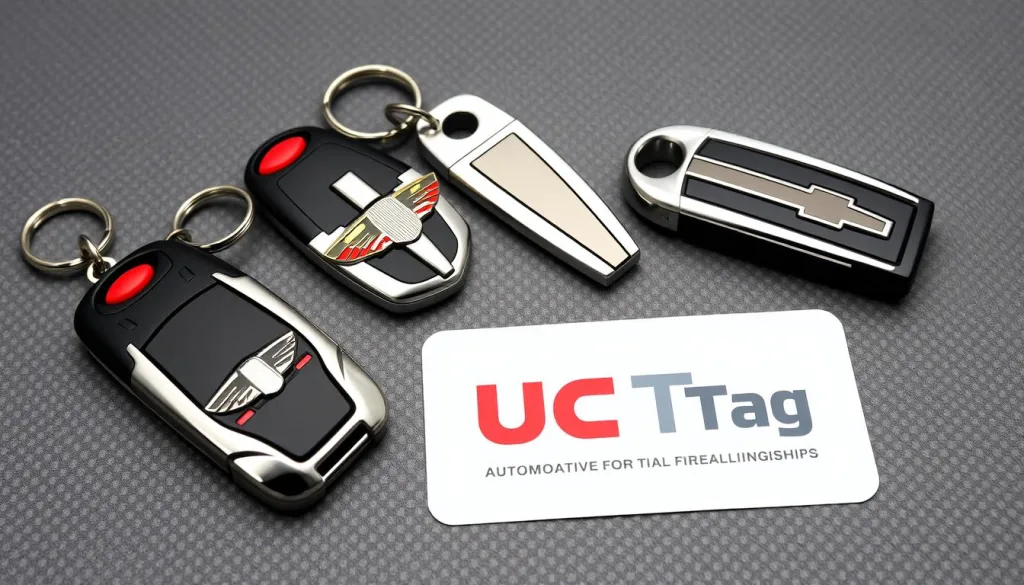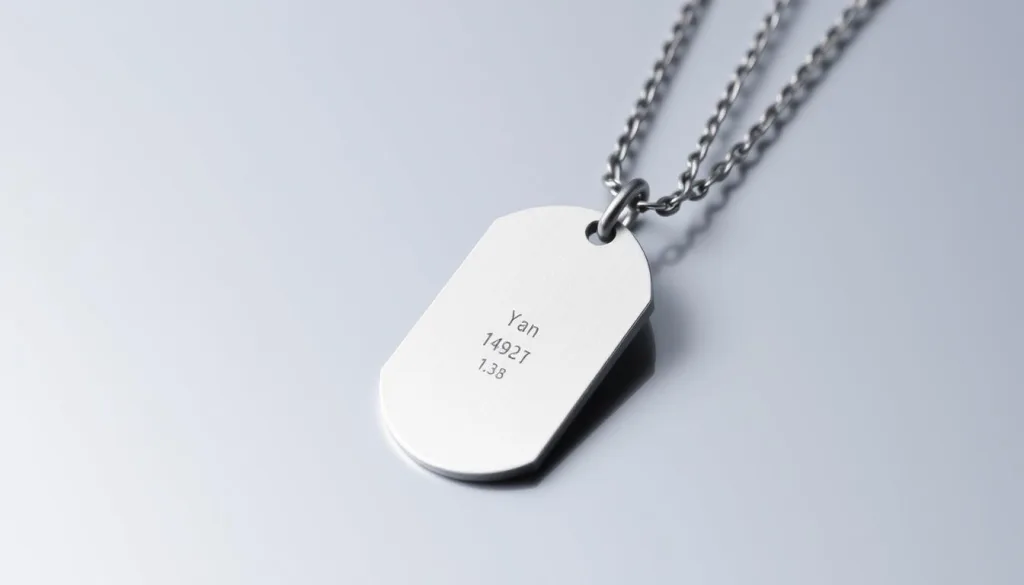When comparing metal tag brass vs aluminum, it’s vital to notice how different they are. Our guide focuses on the pros and cons of each material. This way, you can pick the best one for your needs.
We look into things like how well they stand up to corrosion, their weight, and how strong they are. Plus, we talk about how they look. With advice from industry pros, we aim to help you choose wisely.
Key Takeaways
- Brass tags offer superior corrosion resistance compared to aluminum.
- Aluminum tags are lightweight and often more cost-effective.
- Aesthetic appeal varies significantly between brass and aluminum.
- Understanding the application is crucial in choosing between the two materials.
- Long-term value should be considered alongside initial investment costs.
Introduction to Metal Tags
Metal tags are important in many industries. They are used for marking, branding, and providing product information. They help businesses in different fields by being durable and visible. With uses of metal tags, companies can identify their assets and promote their brands well.
Choosing the right material is crucial in today’s market. When looking at brass and aluminum metal tags, each has its benefits. Knowing these advantages helps us make wise choices for our business and brand.
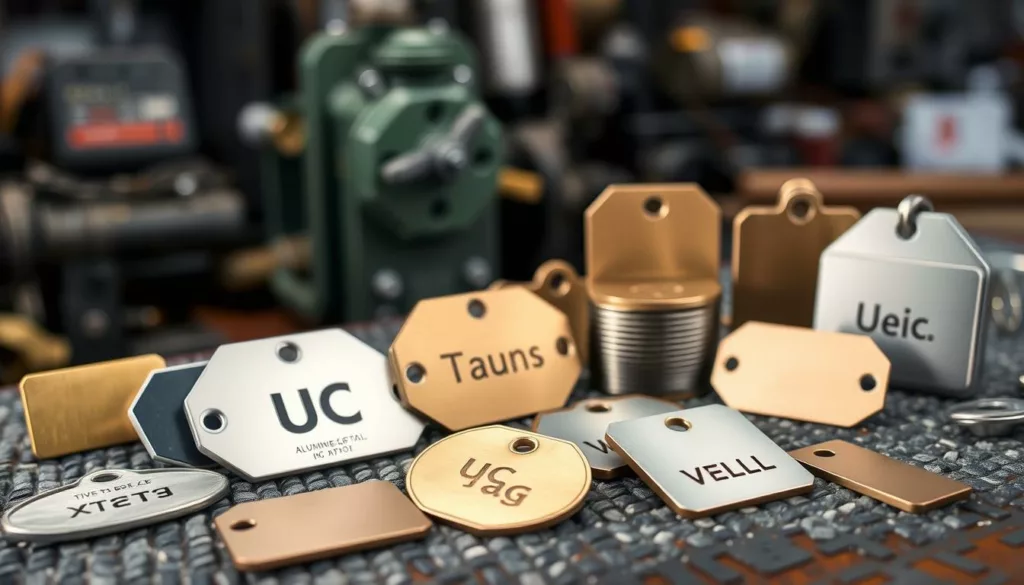
Metal tags offer both function and beauty. They can be used for outdoor signs or product labels. Knowing how important metal tags are can improve our workflows. It can also help our businesses grow.
Understanding the Material Properties of Brass
Brass is mainly made of copper and zinc. It’s popular for making metal tags because of its advantages. Knowing about brass helps us see why it’s great for many uses.
Corrosion Resistance
Brass is known for fighting off corrosion very well. It can handle moisture and many chemicals, making it perfect for outdoor and industrial use. Its toughness means it lasts a long time, saving money on replacements.
Weight and Strength
Brass has an excellent mix of being strong and not too heavy. This makes it possible to create long-lasting tags that are still easy to use. Companies like using brass tags because they work well in many places without losing quality.
Aesthetic Appeal
Brass looks great, with a warm, golden color that stands out. This look makes branding clearer and adds a professional touch. The beauty of brass not only looks good but also helps promote brand identity.
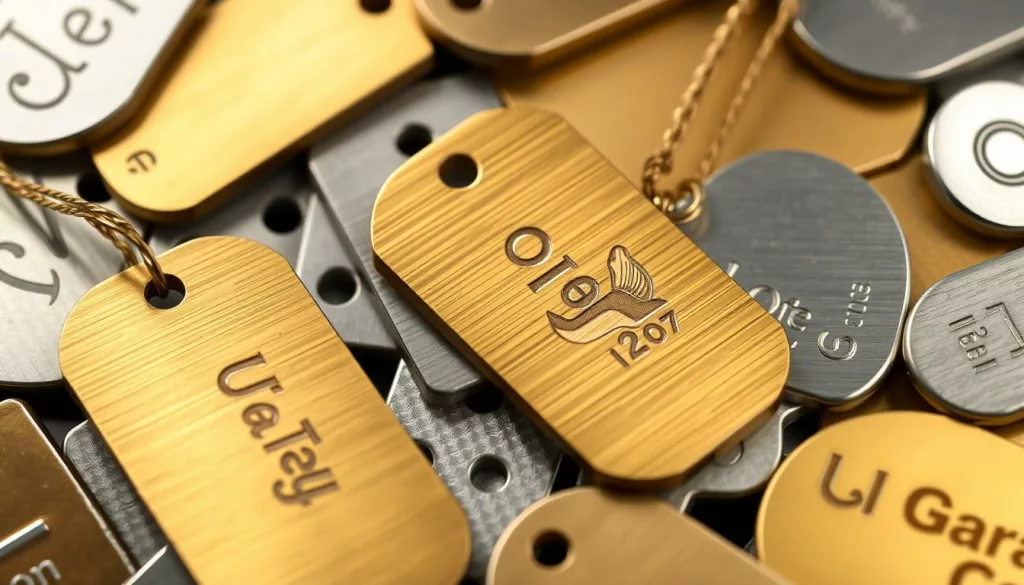
Exploring Aluminum as a Material for Tags
Aluminum is known for its unique features, which make it great for making tags. Let’s look at three main reasons: it’s light, doesn’t cost much, and fights off rust well.
Lightweight Nature
Aluminum tags are valued for being light. This lightweight aluminum makes them easy to carry and use, especially when weight matters. It’s great for movement and lowers the burden when using many tags.
Cost-Effectiveness
Looking at costs, aluminum is a cost-effective tag material. It’s cheaper than materials like brass but still maintains high quality. This makes it accessible for all kinds of uses and industries.
Resistance to Corrosion
Aluminum corrosion resistance is key for tags that last long. Anodized aluminum, in particular, stands up well against water and chemicals. This keeps aluminum tags clear and beautiful for years.
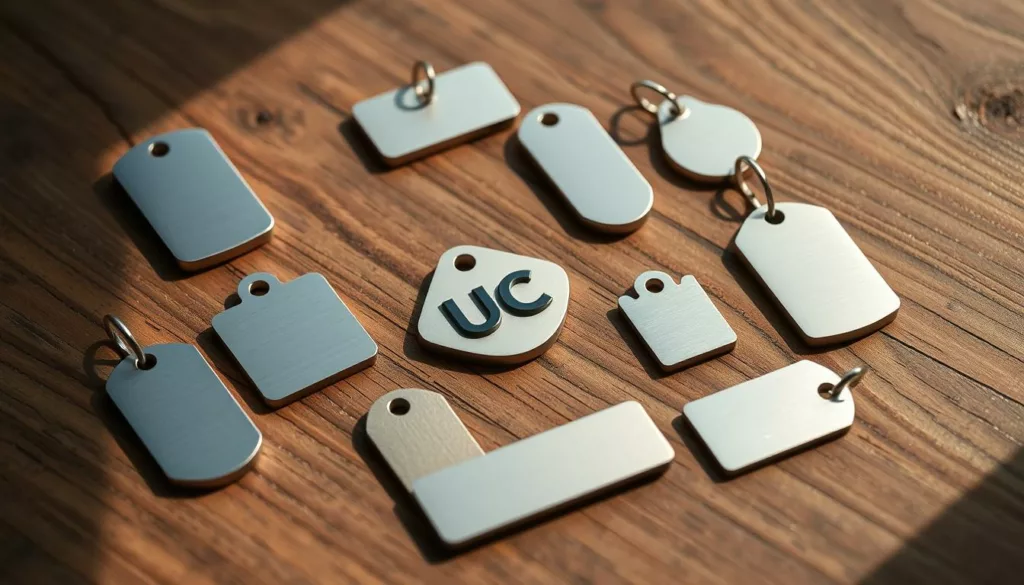
Metal Tag Brass vs Aluminum: Key Differences
When we compare brass and aluminum, each offers unique qualities for various uses. This helps us see how comparing brass vs aluminum tags could shape your choice. These materials carry distinct advantages for specific needs.
This concise look at the key differences between brass and aluminum highlights their strengths and limitations. By understanding these points, better decisions can be made for our applications.
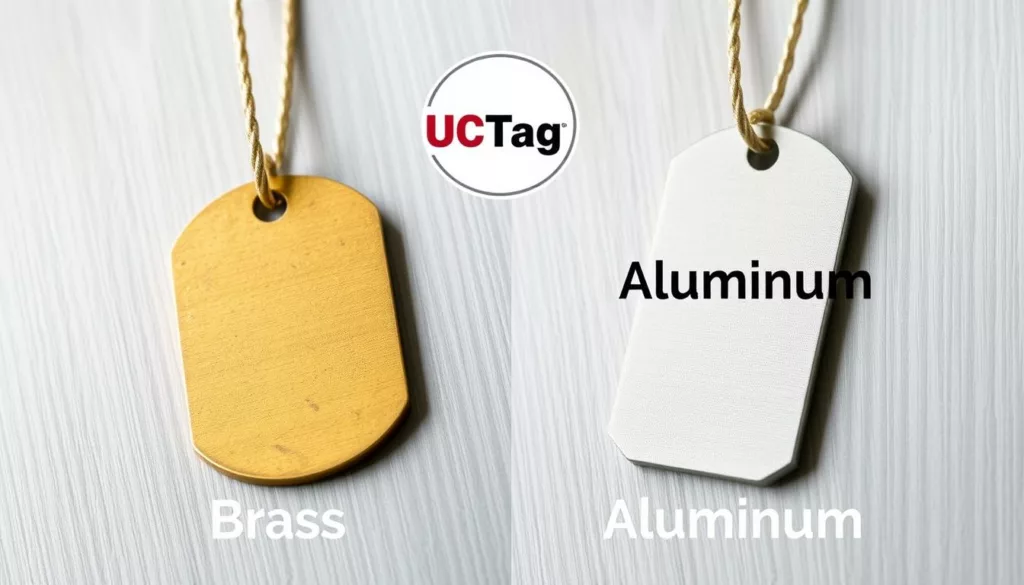
| Attribute | Brass | Aluminum |
|---|---|---|
| Temperature Resistance | High | Moderate |
| Scratch Resistance | High | Low |
| Overall Lifespan | Longer | Shorter |
| Weight | Heavier | Lighter |
Durability and Longevity of Brass Tags
Brass tags are known for their remarkable durability. This makes them stand out for many uses. They last a long time because they are made of strong materials.
They work well in various environmental conditions. We will look into how well brass resists the environment. We will also see what causes wear and tear.
Environmental Resistance
Brass is a top choice for tags because it resists harsh environments well. It can handle big changes in temperature and humidity. This keeps it in good shape.
Brass is also good at fighting off corrosion. This means tags stay functional and look good, even in tough conditions. Knowing this gives us confidence that brass tags can last.
Wear and Tear Factors
Even though brass tags are very durable, they can show wear. Things like friction and rough handling can damage them. But they often last longer than aluminum tags under the same conditions.
Knowing what causes wear helps us pick the right uses for brass tags. It also helps us take care of them better. This way, they keep being useful for a long time.
| Aspect | Brass Tags | Aluminum Tags |
|---|---|---|
| Corrosion Resistance | Excellent | Good |
| Temperature Tolerance | High | Moderate |
| Longevity | Long-lasting | Moderate lifespan |
| Weight | Heavier | Lighter |
| Wear Resistance | High | Moderate |
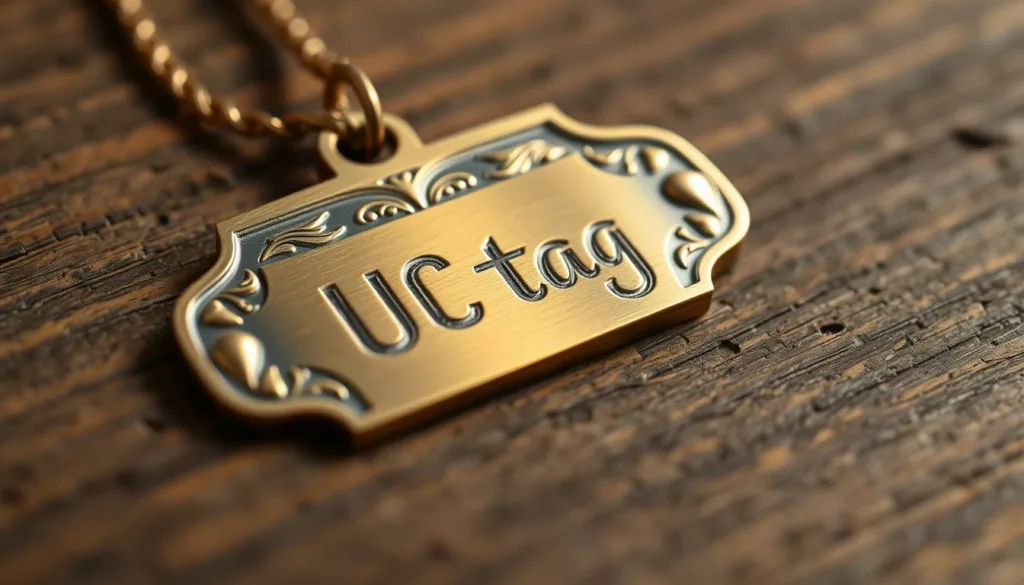
Durability of Aluminum Tags
Aluminum tags are known for their outstanding durability and long life. They are popular because they’re strong yet lightweight. This makes them great for tough uses.
Life Span in Different Conditions
The life of aluminum tags changes based on where you use them. In places with lots of corrosion, they last a long time because they resist oxidation. If they’re near water or salt, they do better than many other materials.
Brass tags, for example, might tarnish and need more care. But aluminum stays consistent over time. This makes aluminum tags versatile for indoor and outdoor needs, keeping their quality.
Impact Resistance
Aluminum tags are also tough against impacts. They don’t crack or break easily, which is perfect for hard situations.
In places like construction sites or farms, they handle rough treatment well. This durability means they keep working, making them a reliable choice for tagging.
| Material | Lifespan in Corrosive Environments | Impact Resistance |
|---|---|---|
| Aluminum | 10-15 years | High |
| Brass | 5-10 years | Medium |
This table shows why aluminum tags are a better choice. They last longer and stand up to impacts well. When you pick aluminum tags, you’re choosing durability for tough conditions.
Brass and Aluminum Metal Tag Comparison
When looking at brass versus aluminum metal tags, we study important qualities. These qualities affect their use in different settings. Both materials have unique features that serve various needs and likes.
We’ve made a comparison table to show the important parts of each material:
| Feature | Brass Tags | Aluminum Tags |
|---|---|---|
| Durability | High resistance to wear and tear | Good, but less than brass |
| Corrosion Resistance | Excellent in various environments | Very good, especially in industrial settings |
| Weight | Heavier and more solid | Lightweight and easy to handle |
| Aesthetic Appeal | Classic, elegant gold tone | Sleek, modern appearance |
| Cost | Generally higher initial investment | More affordable upfront |
| Applications | Luxurious workshops, boutique labels | Mass production, industrial tags |
This comparison of brass and aluminum tags shows that our choice depends on what we need. Whether it’s about lasting long or looking good. Understanding the features of brass and aluminum tags helps us make smart choices for our specific needs.
Choosing the Right Material for Your Needs
When looking at choosing metal tags, knowing about brass and aluminum tags is key. Each one has special benefits for different uses and settings. Let’s dig into what makes brass and aluminum tags great for various needs.
Applications for Brass Tags
Brass tags are valued for their strong and good-looking nature. They work best where resisting rust is crucial, for example:
- Marine environments, due to constant saltwater contact.
- Industrial uses like labeling machinery and keeping track of stock.
- For art, like decorative panels and signs because of their attractiveness.
These uses show how brass tags mix function with beauty across areas.
Applications for Aluminum Tags
Aluminum tags are chosen for being light and affordable. They fit well for many needs such as:
- Labeling gear in storage and during transport because they’re light.
- Name tags for events like talks or shows.
- Keeping track of conditions in the outdoors where weight and rust matter.
Knowing how aluminum tags are used helps pick the best choice based on need and cost.
Cost Considerations: Brass vs Aluminum Tags
Choosing between brass and aluminum tags involves understanding their costs. We look at their initial prices and long-term values. This knowledge helps us pick the best option for our money and needs.
Initial Investment
Initial costs are key in deciding between brass and aluminum. Brass tags cost more at the start because they’re strong and look good. Yet, aluminum tags are cheaper, appealing for those on a tight budget. Here are the initial costs for each.
| Tag Material | Average Cost per Tag | Features Affecting Cost |
|---|---|---|
| Brass | $1.50 – $3.00 | Durability, Aesthetic Appeal, Corrosion Resistance |
| Aluminum | $0.50 – $1.50 | Lightweight, Cost-Effectiveness |
Long-Term Value
Long-term value also matters when picking brass vs aluminum tags. Brass tags last longer, even in tough conditions. This means you might save money over time because you won’t replace them as much. Aluminum tags, though cheaper upfront, might need more frequent replacements. Thinking about these long-term aspects helps us make the best choice.
Conclusion
In looking at metal tags, we examined the qualities of brass and aluminum. Each has unique traits for various uses. Making the right choice depends on your specific needs.
This summary compared brass and aluminum, focusing on durability, cost, and how they stand up to the environment. Understanding these points helps us see their value and suitability for different uses.
Choosing the correct material for your metal tags will make you happier and more successful with your work. We hope this guide has given you the knowledge to pick wisely for your needs.
FAQ
What are the key differences between brass and aluminum metal tags?
Brass and aluminum metal tags differ in several key ways. Brass tags are heavier and have a more premium look. On the other hand, aluminum tags are lightweight and cost less. Each type resists corrosion differently, making them suitable for various settings.
Which metal tag is more durable, brass or aluminum?
Brass tags are known for their durability in tough environments, thanks to their corrosion resistance. Anodized aluminum tags also offer significant durability and are lighter. Your specific needs and environment will guide your choice.
Are brass metal tags more expensive than aluminum tags?
Yes, brass tags usually cost more up front than aluminum tags. But remember to think about their long-term value. Brass can last longer, which might save money over time.
In what applications are brass metal tags preferred?
Brass metal tags are perfect when you need an elegant touch. They’re great for high-end branding, jewelry, and memorial plaques. Their look and corrosion resistance make them ideal for both indoors and outdoors.
Why would one choose aluminum tags over brass tags?
One might pick aluminum tags over brass for their lightness and lower price. They also resist corrosion well when anodized. These tags work well for light applications or when saving money is key.
How do environmental factors affect the lifespan of brass and aluminum tags?
Things like humidity, temperature changes, and chemicals can affect how long brass and aluminum tags last. Brass is often better for tough conditions. Aluminum suits milder settings, especially when treated to resist corrosion.
Can I engrave both brass and aluminum tags?
Yes, you can engrave both types. Brass engravings look pleasing, while aluminum gives a modern vibe. The best choice depends on the look you want and how you plan to use the tag.
What should I consider when choosing between brass and aluminum metal tags?
Think about the tag’s purpose, the environment, your budget, and style preferences. Knowing these will help you choose the right material.
Are there any maintenance requirements for brass and aluminum tags?
Brass tags might need some polishing now and then to keep their shine and prevent tarnish. Aluminum tags usually need less care because they resist corrosion. Knowing what each material requires can help you decide which is best for you.
